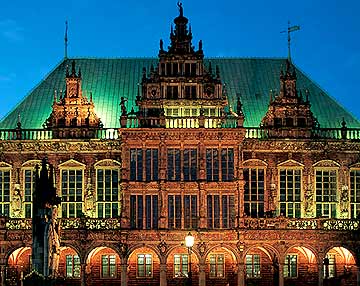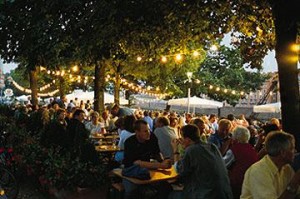
I wonder if there’s a body out there that can rescind qualifications you’ve acquired in the past. Since a GCSE passed with flying colours 20 years ago, the only German I’ve encountered has been sung at me on my iPod by David Hasselhoff and the odd choir – and you can tell. Reduced to gurning, miming and pointing over schnitzel and pig knuckles, I am reminded that the brain is a muscle, blah blah blah, and that a mild attempt to keep up learned skills in adulthood might not have been a bad thing. If you intend to enjoy eating while travelling in a European country where you don’t speak the language, you could do a lot worse than pick up a copy of Eating Out in Five Languages, which fits nicely in your handbag or a coat pocket and covers 10,000 restaurant and food terms in English, French, German, Spanish and Italian. I found it invaluable, and it’s always reassuring to know that the words for lark, nettle or lung are just a quick flip away.
If there were such a thing as a bloggers’ licence, I should probably have that rescinded too. I’ve just spent a week in a city a-throb with UNESCO World Heritage sites, and I managed to leave my camera out of the hand luggage while trying to get the case to meet Ryanair’s weight restrictions, and forget to put it back in again. All the pictures you see here are courtesy of the Bremen tourist board.
So, you’re in North Germany. You’re probably thinking sausage, and you’re definitely thinking beer. The local cuisine is heavy on the meat, light on the vegetables, tends towards onions for flavouring rather than garlic, and favours mustard and caraway above pretty much every other spicing. You’ll find the local foods all over the city, in bierkellers, restaurants, and in the biergartens strung like beads along the river Weser.
Your first destination in Bremen should be the market square. This is where all the UNESCO World Heritage goodies are – a statue of Roland and the gothic fruitcakery of the Ratshaus (town hall), both built around 1405. If it isn’t supper time yet, you can fill any gaping holes you might possess with a wurst; there are three permanent stalls here to the left of the town hall where you can pick up a sausage in a bun, with some potato salad, or without any accompaniment at all. Currywurst (in Bremen sometimes called Kanzlerschnitzel, or Chancellor’s Schnitzel – any German speakers know why?) is a popular choice: a grilled sausage slathered with sweet tomato sauce, then dusted with garam masala. There’s no chilli heat at all in one of these beasts, but plenty of flavour from the curry spices.

Underneath the Ratshaus, you’ll find the Ratskeller, an enormous cellar tavern which originally housed all the wine sold in the 15th century city. Now, if you are someone with a horrible addiction to computer role-playing games of the medieval fantasy sort (not that I know anyone like that. Oh no), you’ll be all over this place. It’s the perfect instantiation of ye olde cellar tavern, all vaulted ceilings, sconces just aching for a flaming torch, cast-iron stands for your coat and your sword, and gorgeously baroque dark wood carvings. Seated next to a gargantuan wine barrel with armorial markings from 1740-odd, I was perfectly primed for an attack from a party of kobolds while I wrestled with my Bremer Knipp.
Knipp (pronounced with a hard “K”) is a very local dish you’re unlikely to find elsewhere in Germany. The closest you’re likely to have come to it in the UK is a haggis; Bremer Knipp is made from oats, beef liver, pig’s head and pork belly, seasoned with onion and some sweet spices, all minced together into a patty and fried crisp in lard. You’ll be thankful for the pickled gherkin it’s served with, which neatly cuts the fatty richness of the Knipp. We found ourselves big fans of Bremer Knipp; if you’re someone who enjoys offal, you’re likely to like it too. (If you’re a haggis-avoider, give it a miss.) The local dishes seem to be by far the best at the Ratskeller: try the Labskaus, a sort of corned beef, potato and onion hash.
Two minutes’ walk away you’ll find Böttcherstrasse, about 100m of narrow medieval street as reimagined by 1920s expressionist architects in brick. It’s a jewel of a place (look out in particular for the Haus des Glockenspiels, where a carillon of bells made from Meissen porcelain plays an eight-minute concert on the hour in the daytime) lined with little shops and restaurants. We particularly enjoyed the cavernous Ständige Vertretung, a beer hall themed, rather weirdly, around German politics. My, the conversations we ended up avoiding for reasons of cultural sensitivity over our herrings. Beer here – frothy, crystal-clear Kräusen from the local Haake Beck brewery by default, although you can choose other beers – is sold in little 20cl glasses, which are topped up as the evening goes on. (They’re fragile; clink, if you must, with the bottoms rather than the tops. My friend T ended up with a shard of glass in his pilsner.) A tally is kept on your beermat; it’s easy to drink a lot like this, but when you feel you’ve had enough, just pop your beermat on top of your glass.
Take a left at the top of Böttcherstrasse, and with another few minutes’ brisk trotting, you’ll find yourself in the Schnoor district, a maze of medieval streets. Restaurants here tend towards the touristy (avoid the Beck’s restaurant), but Schröter’s Leib und Seele, especially on a sunny day, is a great lunch spot – and there were more vegetables on the menu here than I saw anywhere in the rest of the city. It’s attached to Schröter’s Konditorei (cake shop), so save plenty of room for dessert, which is the best part of the meal here.

The city’s set up for long, drinky evenings. You’ll find atmosphere in buckets in all the places I’ve mentioned, but on a sunny day you’re best off by far along the river embankment (Schlachte). Here, you’ll find a line of terraces under the trees, where you can eat from the restaurants opposite the river. At weekends, pigs appear on spits, mackerel is grilled over coals and things get substantially busier than they are in the week. We spent a lot of time sitting at the picnic tables here, soaking up a positively professional amount of beer with sausages and schnitzel. My favourite spot along the Schlachte is Paulaner’s, where there are actual honest-to-god beer wenches, with boobs hoisted up near their chins on a sort of lacy shelf arrangement. Great schnitzel, too, served at this time of year with beautiful fat white asparagus and hollandaise (everywhere has a seasonal menu featuring asparagus at the moment; I wish we’d pick up on this idea in the UK), along with a totally unnecessary lake of butter.
Alcohol-aided bravery might be necessary for you to try out another local trick in the beer gardens: white wheat beer with a shot of flavoured syrup. You’ll find banana (a really surprisingly good flavour match to the hoppy Weissbier), cherry and Waldmeister (woodruff), which turns your beer a startling green and gives it an aromatic, honeyed flavour. Woodruff beer is also called Mai-Bier (May beer), and is meant as a particular springtime drink. Just be ready for a little teasing when you order one of these – on ordering a Pilsner and a banana-flavoured Franziskaner Hefe-Weisse I was told by a smirking fella in an apron: “Hier ist das Bier für einen Menschen. Und hier ist ein Bier für ein Mädchen.”
Even I have enough German to understand that.

A friend sent me a link to this entry and being from Bremen, I have to say, well done! Really covered the best things (Kräusen & Knipp) in summer. If you come back in winter some time, check out Kohl und Pinkel. For me, this is the no. 1 culinary specialty from Bremen and the northwest, but only available in winter. And a good spot for this (and Knipp in summer) is “Zur Schleuse” (www.geffken-zur-schleuse.de). It’s pretty far out, but it’s beautifully located on the Wümme river and I swear they have the best Bratkartoffeln I’ve ever had!
Thanks Thilo; it’s very nice to have a local seal of approval! Notes have been made for any future winter visits, so watch this space.
Hi its a very nicely written article (although I prefer to enjoy other meals than Knipp and “Kohl und Pinkel”)!
By the way, I like to comment on your question why the Currywurst is called “Kanzlerschnitzel”. During the Cancellorship of Gerhard Schröder (1998-2005) his preferred meal supposed to be the “Currywurst”. If I`m not mistaken, this lead to this denotation which can be translated as the chancellor`s schnitzel. I think you went to the restaurant “LUV” ?
Referring to Thilo`s comment I like to add that when you visit Bremen in Winter, then don`t miss the famous “Kohltour”… ;-).
Pretty much everyone I met in Bremen was *super* enthusiastic about Kohl and Pinkel. Looks like I need to do a trip in the winter for your magical cabbages!